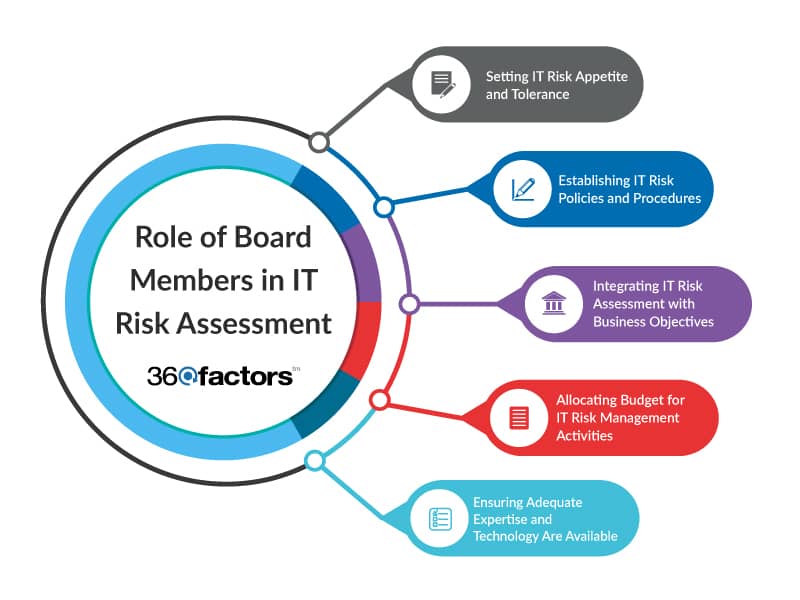Home/ Blog / Roles and Responsibilities of Board Members in IT Risk Assessment
A rising number of organizational board members understand that cybersecurity is a business risk that they must address and ensure proper risk mitigation strategies are in place. Recognizing the profound importance of mitigating IT risks, board members are playing a pivotal role in ensuring the resilience and security of their organization’s IT infrastructure.
This blog explores the essential roles and responsibilities that board members undertake in the realm of IT risk assessment and highlights how Predict360 ITRA can support organizations in their efforts.
Importance of Board Members in IT Risk Assessment
An organization’s leaders, especially the board directors, play a critical role in effectively mitigating cyber risks. Recent research into board oversight reveals a critical need for a shift in the information provided to boards for meaningful cybersecurity conversations.
Traditionally, IT cybersecurity discussions have centered around technology and organizational metrics, such as the results of phishing exercises. However, these metrics fall short in aiding boards with their fiduciary responsibility to manage cyber risk effectively. To bridge this gap, a new approach is necessary—one that aligns with a balanced scorecard framework applied to cybersecurity.
The research also highlighted the challenges boards face in discussing cybersecurity at a meaningful level. It showed that board directors are keen on understanding the real cyber risks their organizations face from a business perspective. One C-level technical leader emphasized the board’s interest in resilience and the value they place on insights and comparisons with peer organizations.
Critical information sought by board members includes details on IT system assets, proactive cyber defense capabilities, recovery timelines, financial implications of data breaches, and third-party technical risk assessments. Additionally, there is a growing interest in understanding the capabilities and protection of suppliers. While some uncertainty exists about the inclusion of technical and supply-chain details in board IT risk oversight, it is evident that boards are seeking a comprehensive understanding of cybersecurity vulnerabilities and their organizational impact.
To ensure smooth IT risk governance, board members may delegate cybersecurity responsibility to audit and risk committees, welcoming feedback from these committees. The lack of tools for boards to perform appropriate cybersecurity oversight has emerged as a notable concern, emphasizing the need for a comprehensive IT risk assessment solution.
Role of Board Members in IT Risk Assessment
Board members can play a more active role in IT risk assessment and management in the following areas.

Setting IT Risk Appetite and Tolerance
Board members are responsible for defining the organization’s appetite for IT risk and determining the acceptable tolerance level of risk. This involves considering factors such as industry standards, regulatory requirements, and the overall risk landscape.
Board members must ensure that this defined risk appetite aligns with the broader business objectives. This requires a keen understanding of the organization’s strategic direction, enabling board members to strike a balance between digital innovation and IT risk mitigation.
Establishing IT Risk Policies and Procedures
Board members also play a vital role in establishing comprehensive IT risk policies and procedures. This demands a strategic mindset to create a robust risk management framework. Board members must oversee the development of policies that comply with regulatory standards and reflect the organization’s unique risk profile.
This involves looking into the specifics of risk monitoring, identification, and assessment, as well as laying out clear response and recovery strategies. By actively shaping these guidelines, board members ensure that the organization is well-equipped to navigate the evolving landscape of IT risks with resilience and agility.
Integrating IT Risk Assessment with Business Objectives
Harmonizing IT risk assessment with the organization’s overarching business objectives is a multifaceted task that requires a thorough understanding of both technology and business strategy. Board members act as the bridge between these two realms, facilitating integration that goes beyond mere alignment.
The board must take an approach where IT risk assessment becomes an integral part of strategic decision-making, influencing business processes and innovations. This involves fostering a culture that recognizes the relationship between risk management efforts and the pursuit of long-term business goals. The result is a holistic approach to risk management that strengthens the organization’s overall strategic resilience.
Allocating Budget for IT Risk Management Activities
Board members play a pivotal role in the financial stewardship of IT risk management by allocating budgetary resources. This involves an analysis of the organization’s risk landscape, identifying potential threats, and prioritizing mitigation efforts accordingly.
Board members must strike a delicate balance between risk mitigation and fiscal responsibility, recognizing that a proactive approach to risk management is not only a safeguard against potential financial losses but also a strategic investment in the organization’s future sustainability. This financial acumen ensures that the organization is adequately resourced to face the dynamic challenges posed by the evolving IT risk landscape.
Ensuring Adequate Expertise and Technology Are Available
Board members cognizant of the intricate nature of IT risks must take proactive measures to ensure their organization possesses the requisite expertise and technology. This involves a thorough assessment of the skill sets within the organization, identifying gaps, and strategically addressing them through tools and resources.
Board members can advocate for continuous professional development to keep the workforce abreast of emerging threats and technologies. Simultaneously, they champion investments in cutting-edge technologies that enhance the organization’s ability to conduct thorough risk assessments and implement effective mitigation strategies. This holistic approach to talent and technology management ensures that the organization is ready for existing challenges and prepared against the possibility of future IT risks.
Major Responsibilities of Board Members
The board members bear significant responsibility for ensuring the IT risk assessment process is working effectively. Some of the significant elements of this responsibility are outlined below.
Periodic Assessment of IT Risk
Board members must oversee the regular assessment of IT risks, ensuring that potential threats are identified and evaluated in a timely manner.
Collaboration with Organizational IT Talent, Including CIO and CISO
A collaborative relationship between board members and IT leadership, including the Chief Information Officer (CIO) and Chief Information Security Officer (CISO), is vital for effective risk management.
Reporting Cyber Risk Assessment Findings to Stakeholders
Transparent communication of risk assessment findings to stakeholders, including shareholders and employees, fosters a culture of trust and accountability.
Reviewing of Risk Mitigation Strategies to Industry Benchmarks
Continuous evaluation of the effectiveness of risk mitigation strategies is another key responsibility, allowing the board to adapt and enhance the organization’s defenses against evolving threats, based on industry best practices and comparative analysis.
Building a Culture of Risk Awareness
Promoting a culture of risk awareness throughout the organization is the ultimate responsibility of board members, and they must actively embrace it, encouraging all employees to be vigilant against potential threats.
Ensuring Transparency in Reporting
Board members ensure that the reporting of IT risk assessments is transparent, providing accurate information to stakeholders for informed decision-making.
Training on Best Practices in IT Risk Management
Board members must also ensure that employees receive adequate training on best practices in IT risk management, empowering them to contribute to the organization’s overall security posture.
Conclusion
In today’s interconnected digital landscape, the board plays a crucial role in the success of any organization’s IT risk assessment and mitigation practices. The right tools can help them get on top of IT risk management strategy.
Predict360 IT Risk Assessment is an advanced solution that provides robust support to board members. The application offers comprehensive features that streamline IT risk assessments and monitoring processes, ensuring that organizations can navigate the complex world of IT risks with confidence.
With Predict360 IT Risk Assessment Software, board members can leverage advanced analytics, real-time monitoring, and customizable reporting tools to make informed decisions and proactively address emerging IT risks. By embracing technology and best practices, board members can fulfill their roles and responsibilities effectively, safeguarding the organization against the ever-evolving threats in the digital frontier.
Request a Demo
Complete the form below and our business team will be in touch to schedule a product demo.
By clicking ‘SUBMIT’ you agree to our Privacy Policy.



